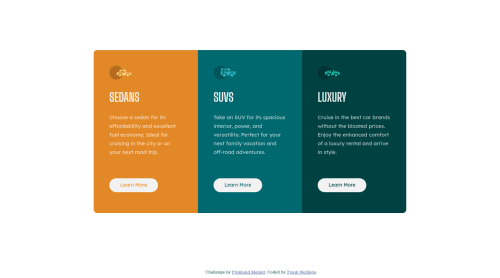Responsive Flexbox 3 column layout

Solution retrospective
I am wondering if there is a more efficient way to program the buttons. I gave them a general class but then had to use IDs when styling the individual colours and hover behaviours. I feel like there would be an easier way for this.
Please log in to post a comment
Log in with GitHubCommunity feedback
- @nilanshu96
Your solution looks pretty good. For button the better solution would be to use the following for hover
.learn-more-button:hover { background-color: transparent; color: var(--very-light-gray); }For this to work you need to add a 1px solid white border on the button's class by default so that you won't have to add it separately for hover. Since the border and button's background would have the same color it won't be visible in button's normal state.
- @tediko
Hello, Tyson! 👋
Good effort on this challenge! Everything works good and responds well. In addition to both nilanshu and brasspetals feedback I'd suggest you to take a look at:
- Change the
altattributes for the.leading-vector-imagesicon images, as they don't add any extra context for screen reader users. Since your images are decorative youralttext should be provided empty (alt="") so that they can be ignored by assistive technologies. - Change
width: 300pxfor your.column-cardon mobile to100%. This way your container will be growing with screen size. Now your solution is only looking good on mobile/desktop.
Good luck with that, have fun coding! 💪
- Change the
- @brasspetals
Hi, Tyson! Congrats on submtting another solution! 🎉 It looks good and responds well.
I'm seconding Nilanshu's solution to the button styling. I do have a small suggestion concerning those buttons, however. They're actually "button-styled links" rather than buttons, as they don't have any button functionality. Switching
buttonout foratags instead would be more semantically correct. This is a very common mistake, which I've been guilty of myself in the past! 😅
Join our Discord community
Join thousands of Frontend Mentor community members taking the challenges, sharing resources, helping each other, and chatting about all things front-end!
Join our Discord